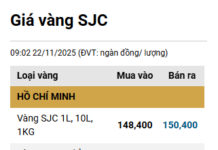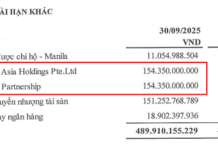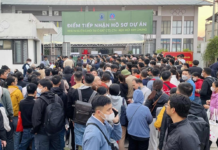Mien Dong Bus Station has been serving Ho Chi Minh City since before 1975, originally located on Le Hong Phong Street (at the border of District 5 and 10). In 1981, it moved to Ward 26 in the former Binh Thanh district. For many years, it was the city’s largest bus station, bustling on weekends and holidays. However, due to its inner-city location, the surrounding area often experienced severe congestion on National Highways 13, Nguyen Xi, and Dinh Bo Linh.
To alleviate this congestion and pollution, in 2016, Ho Chi Minh City decided to build a new station with the aim of relocating this transport hub to the outskirts. The new Mien Dong Bus Station was constructed on a 16-hectare area in the former District 9, with a total investment of VND 4,000 billion. It can serve over 7 million passengers annually, making it the largest interprovincial bus station in the country.
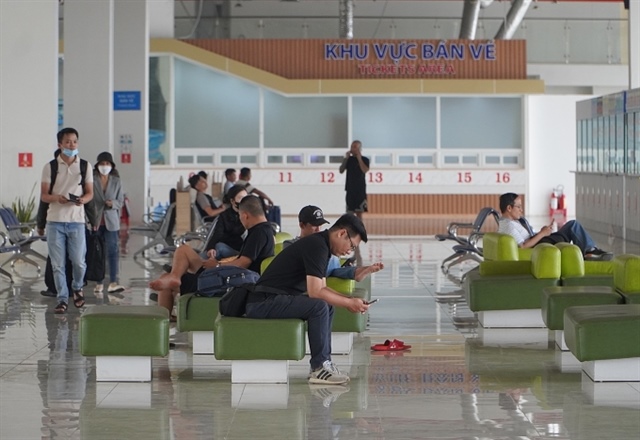 Mien Dong Bus Station in January 2025. Photo: Giang Anh |
After four years of construction, the first phase of the project was completed with a total investment of over VND 773 billion. It began operations in October 2020 and was expected to give a new face to Ho Chi Minh City’s passenger transport and reduce pressure on the old station. However, in reality, the new station has been struggling with low passenger numbers over the years, mainly due to its distant location, approximately 15 km from the old station, and inconvenient transportation connections.
After five years of operation, the new Mien Dong Bus Station has not even reached 10% of its capacity. Currently, the average daily passenger count is around 6,400, with 375 bus trips, despite most long-distance routes from Ho Chi Minh City to the central and northern regions being relocated here.
Representatives of the new Mien Dong Bus Station stated that with the upcoming operation of the Ben Thanh – Suoi Tien Metro line by the end of 2024, along with an improved bus network, they expect a slight increase in passenger numbers. In addition to limited connectivity, the prevalence of “illegal taxis and unofficial stops” also hinders the station’s competitiveness.
The project’s initial goal was to form a major transportation hub in Ho Chi Minh City, integrated with the national transportation network and oriented towards transit-oriented development (TOD). However, to date, the transportation connections to the station remain incomplete. Large-scale projects such as the expansion of Hanoi Highway and the National Highway 1 from Tram 2 to Tan Van, which are being implemented through the BOT model, are behind schedule. Direct connections to the station, such as overpasses and tunnels, are also stagnant. Upgrades to Hoang Huu Nam Street and other surrounding routes have not been completed, making access to the station inconvenient.
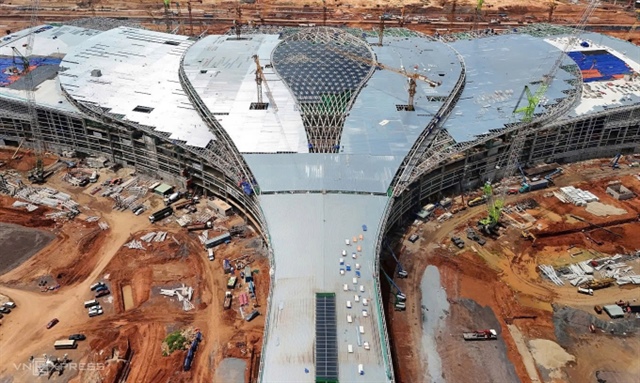 Long Thanh International Airport’s passenger terminal is nearing completion, August 2025. Photo: Phuoc Tuan |
Many experts draw parallels between the situation of the new Mien Dong Bus Station and that of Long Thanh International Airport – the largest aviation infrastructure project in the country today.
Long Thanh International Airport is being constructed in Dong Nai Province, spanning over 5,000 hectares, with a total investment of nearly VND 336,630 billion. Upon completion of all three phases, the airport will have a capacity of serving 100 million passengers and 5 million tons of cargo annually. The first phase is expected to be operational by 2026, serving approximately 25 million passengers and 1.2 million tons of cargo per year.
The airport is envisioned to become an international transit hub, relieving the burden on Tan Son Nhat International Airport, which has been operating beyond its designed capacity (25 million passengers per year) and frequently experiencing traffic congestion on routes such as Truong Son, Cong Hoa, Hoang Van Thu, Bach Dang, and Pham Van Dong. However, Long Thanh currently lacks a synchronized transportation network.
Mr. Le Trung Tinh, Chairman of the Ho Chi Minh City Passenger Automobile Association, warned of a potential scenario of traffic congestion and its impact on passenger convenience at Long Thanh International Airport, similar to what happened with the new Mien Dong Bus Station. He attributed this to the airport’s imminent operation coupled with already congested connecting routes and ongoing or yet-to-be-initiated projects.
According to Mr. Tinh, the connection between Ho Chi Minh City and Long Thanh currently relies on the Long Thanh – Dau Giay Highway, National Highways 1 and 51, all of which are overloaded. Other vital routes such as the Ring Road 3 and the Ben Luc – Long Thanh Highway are still under construction. Additionally, the expansion project of the Long Thanh – Dau Giay Highway has just commenced, and it will take until the end of 2026, at the earliest, to complete it, making it challenging to synchronize with the airport’s progress.
Vietnam Airports Corporation (ACV) and its consultants have proposed two scenarios for dividing flights between Tan Son Nhat and Long Thanh: transferring all international flights to Long Thanh from 2026, expecting to serve over 19 million international passengers annually; or transferring only long-haul international flights while retaining short-haul flights at Tan Son Nhat, with Long Thanh serving approximately 15.3 million passengers.
Mr. Le Trung Tinh believes that transferring all international flights immediately upon the project’s operation is unreasonable. This decision would increase pressure on the connecting infrastructure and cause inconvenience to passengers, especially considering the airport’s distance from Ho Chi Minh City and the incomplete transportation network.
“The 40-kilometer distance from Long Thanh to downtown Ho Chi Minh City raises the risk of traffic jams and flight delays, going against the principle of prioritizing passenger convenience,” he said.
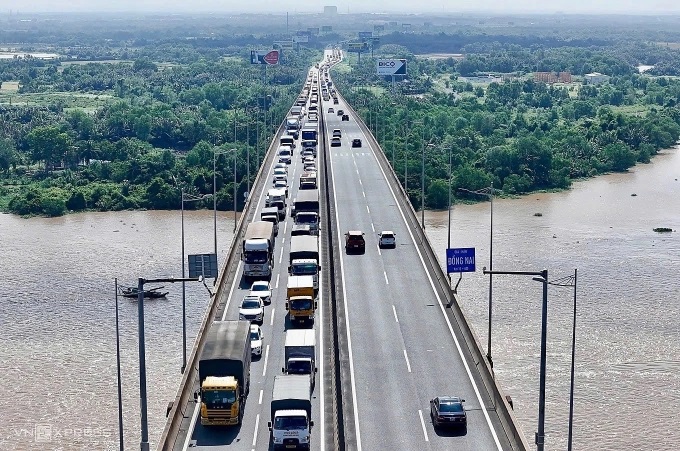 |
Traffic congestion on Long Thanh Bridge on the Ho Chi Minh City – Long Thanh – Dau Giay Highway in 2024. Photo: Giang Anh
|
Architect Ngo Viet Nam Son also emphasized that only when the connecting transportation system is fully completed should international flights be relocated to Long Thanh. He explained that Long Thanh and Tan Son Nhat airports would depend on each other as passengers transferring between international and domestic flights would need to travel back and forth between the two airports, located 40 kilometers apart. Incomplete infrastructure would result in increased costs and travel time, negatively impacting passengers and reducing the project’s effectiveness.
Mr. Son suggested that, for now, cargo operations, logistics, warehousing, and aircraft maintenance should be prioritized at Long Thanh to take advantage of the available land area and reduce the burden on Tan Son Nhat. This would allow for the improvement and enhancement of Tan Son Nhat’s service quality, especially regarding connections between terminals T1, T2, and T3, without the need for further expansion.
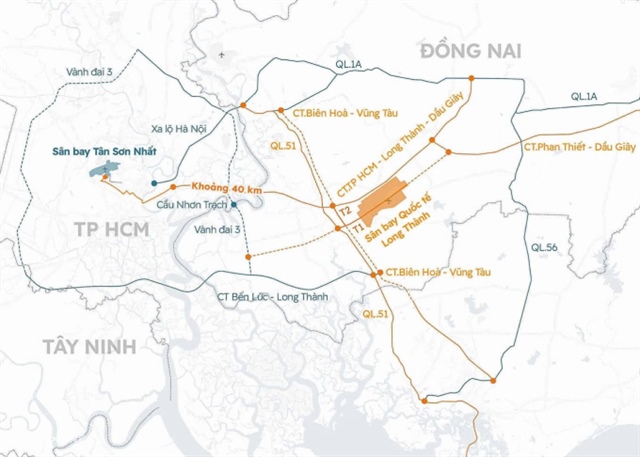 Distance between Tan Son Nhat and Long Thanh airports and connecting routes. Graphic: Hoang Thanh |
Dr. Phan Le Binh, Head of the OCG Japan Consulting Office (providing consulting services in transportation, urban, and environmental fields), stated that the simultaneous operation of two nearby airports has been implemented in various countries. However, this approach also complicates airport operations, leading some countries to adopt coordination policies for the convenience of passengers and efficient operations.
According to Dr. Binh, the current scenarios primarily optimize the benefits for the airport operator, while the criterion of passenger convenience is not clearly addressed. “The aviation industry has a monopoly on flight routes. However, if it causes inconvenience, the long-term effectiveness will decrease, not only for the airport but also for Ho Chi Minh City’s competitiveness compared to other major cities in the region,” he said.
In the short term, Dr. Binh proposed allocating a dedicated bus lane on the Long Thanh – Dau Giay Highway to connect the airport. However, the investment and management costs would need to be shared between the airport operator and the highway management unit.
Drawing lessons from the experience of the new Mien Dong Bus Station, experts unanimously concluded that for Long Thanh International Airport to be successful, the prerequisite is the completion of synchronized connecting infrastructure. Otherwise, there is a high risk of repeating the “low passenger volume” scenario or causing significant inconvenience to passengers.
Giang Anh
– 06:00 20/08/2025
The New Face of Transportation: Unveiling the Can Gio Bridge Project’s Progress
“At a press conference held on August 21st, providing an economic and social update for Ho Chi Minh City, the Department of Construction offered insights into the progress of the Can Gio Bridge project.”
“Ho Chi Minh City Reassesses Land Prices for Three Build-Transfer Projects in Thu Thiem New Urban Area”
The three build-transfer (BT) projects in the Thu Thiem New Urban Area are undergoing a land value reassessment by the People’s Committee of Ho Chi Minh City. These projects, which were under the inspection of the Government Inspectorate, involve a reevaluation of the land already compensated to the investors.
The Abandoned Villa: A Haven for Pests, Yet Prices Soar
“A decade ago, ambitious construction projects were embarked upon in Ho Chi Minh City, yet today, these areas remain sparsely populated. Despite the apparent abandonment, asking prices for these properties continue to rise steadily.”










